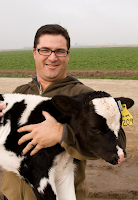 |
Widder, Oliver. (Cartoonist). (2008).
The Web 2.0 Slogan of the Month - May [Cartoon].
Retrieved February 24, 2012, from:
http://geekandpoke.typepad.com
/geekandpoke/2008/05/the-web-20-slog.html |
I'll admit it. When I first heard about Twitter a few years ago, I didn't like it. To me it was unnecessary - wasn't Facebook good enough? And who would care about trivial things that happened in my daily life? True, chances are that no one cares about my thoughts on glycolytic enzymes. However, I was unaware that Twitter had much more to offer than insignificant tidbits of people's lives.
My first time on Twitter was unpleasant. Everything was a mess. There were @ and # symbols everywhere, and tweets were often grammatically chaotic. I preferred Facebook's extremely organized layout. But at the same time, I was curious to find out why people were so crazy about this emerging social media site.
 |
Giacomazzi, Dino. (Farmer). (2009).
Dino Giacomazzi [Photograph].
Retrieved March 1, 2012, from:
http://www.cafwd.org/thinkers/
entry/dino-giacomazzi |
It didn't take long before
ALES 204 changed my cynical view of Twitter. In class, we discussed Twitter in the professional context, especially with relation to agricultural, life and environmental sciences. I learned that there are numerous scientists, farmers, and nutritionists tweeting about latest findings or current trends in their respective fields. I discovered that Twitter can be a useful tool in spreading scientific messages and following meaningful content. For example, dairy farmer Dino Giacomazzi has a Twitter account (
@dairydino) that gives us a glimpse into his farm life. When interviewed in
this article, he said: “We invite people onto our farms through the Internet. We let people see exactly what it is that we do.” I find it fascinating how Twitter enables people to share and promote their passion with others, world wide. My classmate Lina conducted a very interesting
investigation of the role of Twitter and other social media outlets in campus sustainability!
In ALES 204 we also discussed how Twitter forces you to be concise with its 140-character limit. I love to digress, but Twitter prevents me from elaborating into irrelevant territory (to the relief of my followers). Tweeting made me realize that I tend to use unnecessary words that complicate my message. Experienced "tweeps" construct extremely concise tweets packed with meaning.
 |
Ploof, Lindsey. (Student). (2012). Game On [Photograph].
Retrieved March 1, 2012, from:
https://twitter.com/#!/ploofster/status/165536884158763008 |
In addition, I also learned about the value of hashtags, a way to classify tweets. An example of my personal experience with hashtags was during the U of A's Break the Record dodgeball game. Participants tweeted before, during and after the game about participant turnout, team scores, and other exciting material including pictures. Unfortunately, I was unable to attend, but it was amazing how absent people could still
experience the action. Contrarily, a social networking site like Facebook limits you only to what your Facebook friends are up to. I probably had at most three Facebook friends who attended Break the Record. Only one friend posted about the game. On Twitter, I searched for hashtags like #ualberta, #breaktherecord, and #dodgeball, which gave me a plethora of updates from the dodgeball game. Twitter is powerful because it allows people with common interests to form a gigantic network, greatly enhancing the sharing of ideas. It enables you to connect with acquaintances or strangers who share similar passions, without digging into their personal lives.
I'm still a Twitter newbie learning to construct critically literate tweets that demonstrate my engagement with class material. I will continue to use Twitter throughout my academic and professional careers as I now believe that this social networking site has enormous potential.


